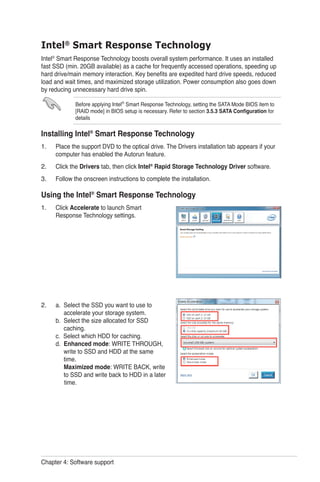

#DISABLE INTEL SMART CONNECT TECHNOLOGY DRIVERS#
In the past I have always used the generic HD graphics drivers from Intel (since they are updated much more frequently than the HP drivers)-turns out that's not a good idea with this computer. I posted on the Intel Communities and they suggested the problem could be that maybe I'm using the generic HD 620 graphics drivers (and that package also includes the Intel Smart Audio Drivers) and that I should be using only the HP provided HD 620 graphics/audio drivers.
HP-please see if your engineers can figure out what the conflict is between your proprietary audio drivers and the Intel Smart Sound Technology. It's a shame that I have to do this (because the sound is not quite as rich), but I just can't stand the popping noise. If this doesn't work for you, simply follow the same directions but choose "Enable Device" instead. If it works, your sound won't be quite as rich as before but the popping should stop. RIGHT click on it and choose "Disable Device". If you have an Intel chip, go to Device Manger, expand System Devices, and look for "Intel Smart Sound Technology OED". The only way I can get rid of the pop sound (and restore my sanity): I believe there is a major conflict between all of the HP provided audio drivers and the Intel Smart Sound Technology, and this conflict causes audio issues. It also happens any time that I skip to a different point in a video (youtube, etc.).
#DISABLE INTEL SMART CONNECT TECHNOLOGY WINDOWS#
Otherwise, use the Intel® UHD brand.Ĭheck for systems that support Intel® Identity Protection Technology (Intel® IPT).I continue to have trouble with a "pop" sound every time I start playing a video (youtube, etc.), anytime that I change the volume, and also during most Windows alerts. Intel® Iris® Xe Graphics only: to use the Intel® Iris® Xe brand, the system must be populated with 128-bit (dual channel) memory. Actual TDP may be lower if not all I/Os for chipsets are used. System and Maximum TDP is based on worst case scenarios.


Processors that support 64-bit computing on Intel® architecture require an Intel 64 architecture-enabled BIOS. See for more information and applicability of this technology. Max Turbo Frequency refers to the maximum single-core processor frequency that can be achieved with Intel® Turbo Boost Technology. See for more information including details on which processors support Intel® HT Technology. Processor numbers differentiate features within each processor family, not across different processor families. Intel processor numbers are not a measure of performance. Please refer to the Launch Date for market availability. Please contact OEM for the BIOS that includes the latest Processor configuration update. Functionality, performance, and other benefits of this feature may vary depending on system configuration. Please check with the system vendor to determine if your system delivers this feature, or reference the system specifications (motherboard, processor, chipset, power supply, HDD, graphics controller, memory, BIOS, drivers, virtual machine monitor-VMM, platform software, and/or operating system) for feature compatibility. ‡ This feature may not be available on all computing systems. Refer to Datasheet for formal definitions of product properties and features. Your company as an importer and/or exporter is responsible for determining the correct classification of your transaction. Any use made of Intel classifications are without recourse to Intel and shall not be construed as a representation or warranty regarding the proper ECCN or HTS. Intel classifications are for informational purposes only and consist of Export Control Classification Numbers (ECCN) and Harmonized Tariff Schedule (HTS) numbers. Please contact system vendor for more information on specific products or systems. The information herein is provided "as-is" and Intel does not make any representations or warranties whatsoever regarding accuracy of the information, nor on the product features, availability, functionality, or compatibility of the products listed. Intel may make changes to manufacturing life cycle, specifications, and product descriptions at any time, without notice. All information provided is subject to change at any time, without notice.


 0 kommentar(er)
0 kommentar(er)
